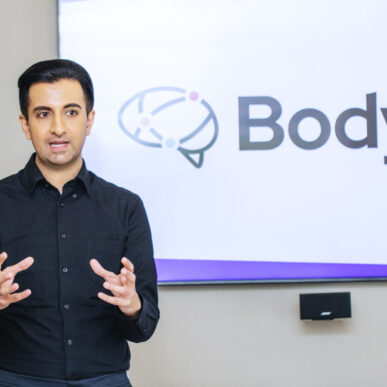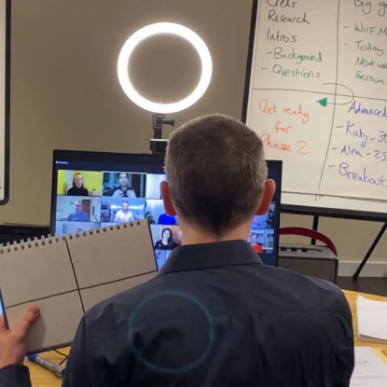“HOW we deliver our information is as important as WHAT we say and can often make or break how our message is received.”
Presenting By The Book – Three Audio Book Techniques To Improve Your Presentations
We may be the authority on our subject matter. We may have years of expertise in our field. Our content may be structured clearly and concisely. But if we rely on these things alone, our meetings and presentations don’t always have the desired impact.
HOW we deliver our information is as important as WHAT we say and can often make or break how our message is received. Consider how often you’ve been in a meeting where you’ve struggled to stay engaged due to the presenter’s delivery. Perhaps you’ve been the presenter and felt your audience’s attention slipping away.
Communication isn’t one size fits all. Different audiences and messages require different approaches. So being flexible in how we prepare and deliver our content is key to maximising its impact.
However, flexibility can require us to step out of our comfort zone, which can be a daunting experience. As a result, we can sometimes choose to play it safe instead of trying something unfamiliar and more effective.
Alongside my work with Body Talk, I’m a professional actor. Recently I was asked to record an audiobook for a publisher specialising in fantasy novels. I’ve recorded many audiobooks over the years, but I hadn’t flexed that particular acting muscle since before the pandemic.
Fantasy novels also come with more challenges than traditional audiobooks: invented words and alien languages; extra-terrestrial characters requiring vocal gymnastics; and – dauntingly – the close scrutiny of a passionate fanbase.
In accepting the job, I knew I had to step outside my comfort zone and adapt my usual audiobook approach. Delivering the best performance would require a different level of preparation and solid technique in the studio.
While recording, I realised that my approach could also be applied to business interactions. So here are three transferrable techniques from the audiobook world to help you swap the well-trodden path for the road-less-travelled with confidence.
Preparation Is Key
The average audiobook takes around 20-25 hours to record. While that may seem like a lot of time, experience has taught me that it disappears quickly if I haven’t prepared my performance beforehand. Many people are surprised to find out that this preparation takes around the same amount of time as the recording itself.
Firstly, I answer some crucial questions that help me to set the tone for the reading. For example: Who is the audience? What are the key themes in the book? What is the arc of the story?
Secondly, I create a roadmap for my performance: How each character will sound, the pacing and pitch of my delivery, which words need stress, and where to breathe in long sentences.
Finally, once I know what I need to achieve, I mark all these details in the text.
The result is a manuscript peppered with shorthand notes, checks and marks that make no sense to anyone but me. But it’s a crib sheet to make sure I hit the right notes when I’m sight reading under pressure in studio.
The same techniques can be invaluable in business meetings and presentations, particularly when we’re feeling under pressure. Things can go awry with all eyes upon us and the heart pumping. Our usually measured delivery might suddenly hit warp speed, or key bits of information may be lost in a monotonous torrent of words. At times like these, a crib sheet can be a lifesaver to get your delivery back on track.
Mark down any directions that you feel will be of use to you. I represent shifts in vocal tone using upward and downward arrows. Double upward and downward arrows remind me to change my pace. If a word is highlighted, I know it will need greater emphasis – this is particularly important the first time any essential information is mentioned.
Whatever personal code you decide to use, the most important thing is that it makes sense to you and can be interpreted with a quick glance at your notes.
Use Your Physicality
Sitting down is one of the things I find most challenging about recording audiobooks. I prefer to stand up when working as a voice actor – it keeps me energised and fuels my performance. Sitting restricts this, but (like in many business meetings) the process of narrating a book requires the actor to be seated.
The biggest danger is getting too comfortable. Becoming too relaxed can lead to a drop in energy, often resulting in bland narration.
The same risk exists in business meetings, particularly those online. A comfortable chair and the temptation to slouch or lean forward on a table can significantly affect your energy level. And if your energy wains, so will that of your audience.
In your next meeting, try sitting in the centre of your chair and raising your sternum – the bony plate in the centre of your chest. This will mean you have an unrestricted flow of air from your lungs. Your voice will be more powerful, and you will also look more engaging to your audience.
You could also experiment with using gestures. When training in radio drama, I was taught to use gestures as the audience would hear the effect, even though they couldn’t see me. It’s a lesson that I’ve never forgotten, and I apply it when narrating audiobooks. The body is the engine behind the voice, so use gestures even if you can’t be seen.
Gestures are also a powerful visual aid for your audience, particularly in a virtual setting where video feeds can be small. Don’t be afraid to use them to guide your audience on how to feel about your message.
Look After Your Voice
I will always have a bottle of water when recording an audiobook. Drinking little and often lubricates the vocal cords, helping to avoid my voice becoming croaky or breathy. A strained voice is distracting and can prevent the audience from clearly hearing what you have to say. It can also cause you frustration, leading to tension which compounds the problem.
To perform at your best, you need to look after your voice. So, if you’re speaking for a long time, always have a bottle of water to hand, particularly if you’re in an air-conditioned office. Don’t be afraid to pause for a drink, and schedule breaks into your meetings if you will be talking for extended periods. Not only will your body thank you, but your audience will appreciate it too.
A final thought on microphones, particularly in virtual meetings or large events. Sometimes people think a microphone will do the work for them by magically injecting their delivery with energy and intensity. It’s important to understand that a microphone only amplifies what you give it. If you are presenting with low energy, the microphone will merely take that low energy and make it louder, making it more conspicuous.
To avoid this, try speaking to a point beyond your audience. If you’re presenting virtually, this might be the back wall of a conference room or the window behind your monitor. Speaking to that more distant point will give your voice more energy and intensity, making your speech clearer and more engaging. You can always turn the gain on your mic down if you’re worried about being too loud.
So, when presenting to an audience, remember these tips to ensure you’re creating maximum impact. Prepare, use gestures to add energy and life to your delivery, and focus on speaking with intention to engage your listeners.
Let Us Help You
Still need some help? We offer many options to help your team communicate like superstars. From masterclasses for large teams or smaller coaching groups, we have something to fit all time frames and budgets. Get in touch today to discuss how we can help you achieve your communication goals.
You can also watch or listen to our podcast below, where I share tips on how to use your voice with impact.
The Body Talk Podcast – The Power Of Your Voice from Body Talk on Vimeo.




















